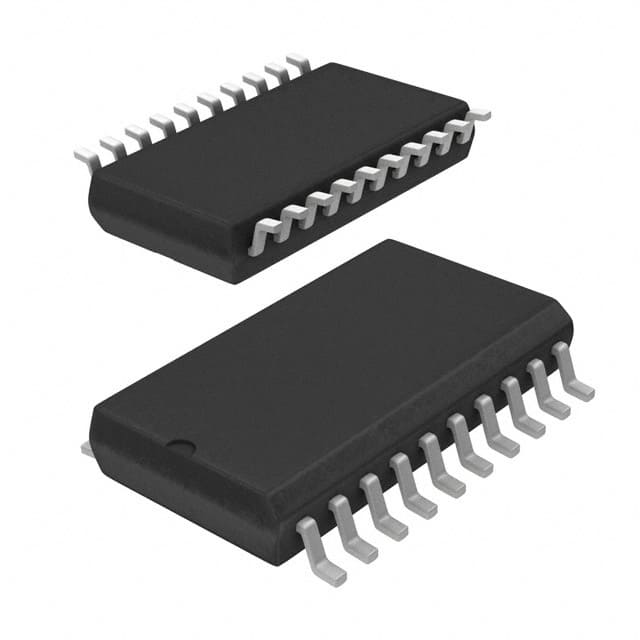Consulte las especificaciones para obtener detalles del producto.

MC74LCX245DW
Basic Information Overview
- Category: Integrated Circuit (IC)
- Use: Logic Level Shifter
- Characteristics: High-speed, low-voltage, bidirectional level shifting
- Package: SOIC (Small Outline Integrated Circuit)
- Essence: Transfers logic signals between devices operating at different voltage levels
- Packaging/Quantity: Tape and Reel, 2500 units per reel
Specifications
- Supply Voltage Range: 2.3V to 3.6V
- Logic Voltage Levels: 1.5V to 5.5V
- Maximum Data Rate: 400 Mbps
- Number of Channels: 8
- Input/Output Type: CMOS/TTL compatible
Detailed Pin Configuration
- OE (Output Enable)
- A1 (Channel 1 Input/Output)
- B1 (Channel 1 Input/Output)
- GND (Ground)
- B2 (Channel 2 Input/Output)
- A2 (Channel 2 Input/Output)
- VCC (Supply Voltage)
- DIR (Direction Control)
- A3 (Channel 3 Input/Output)
- B3 (Channel 3 Input/Output)
- B4 (Channel 4 Input/Output)
- A4 (Channel 4 Input/Output)
- GND (Ground)
- A5 (Channel 5 Input/Output)
- B5 (Channel 5 Input/Output)
- VCC (Supply Voltage)
Functional Features
- Bidirectional level shifting: Allows for seamless communication between devices with different voltage levels.
- High-speed operation: Supports data rates up to 400 Mbps, enabling fast signal transmission.
- Low-voltage compatibility: Works with both low-voltage (1.5V) and higher-voltage (5.5V) logic levels.
- Output Enable (OE) control: Enables or disables the outputs, providing flexibility in signal routing.
Advantages
- Efficient voltage level shifting: Facilitates communication between devices with varying voltage requirements.
- Wide supply voltage range: Can operate within a broad range of supply voltages, enhancing compatibility.
- High-speed data transfer: Supports fast data rates, ensuring quick and reliable signal transmission.
- Compact package: The SOIC package offers a small form factor, making it suitable for space-constrained applications.
Disadvantages
- Limited number of channels: The MC74LCX245DW provides 8 channels, which may be insufficient for certain complex systems.
- Single-directional control: The direction control (DIR) pin allows only one direction of data flow at a time.
Working Principles
The MC74LCX245DW utilizes a combination of CMOS and TTL technologies to achieve bidirectional level shifting. It employs a voltage translation technique that enables seamless communication between devices operating at different voltage levels. The DIR pin controls the direction of data flow, while the OE pin enables or disables the outputs.
Detailed Application Field Plans
- Microcontroller interfacing: The MC74LCX245DW can be used to interface microcontrollers operating at different voltage levels, enabling communication between them.
- Sensor networks: It facilitates level shifting between sensors and microcontrollers, allowing for efficient data exchange in sensor networks.
- Communication protocols: The IC is suitable for level shifting in various communication protocols, such as I2C, SPI, and UART, ensuring compatibility between devices with different voltage requirements.
Detailed and Complete Alternative Models
- SN74LVC245A: Similar bidirectional level shifter with 8 channels, compatible with a wide range of supply voltages.
- TXB0108: Octal bidirectional voltage-level translator with automatic direction sensing, supporting voltage translation between different logic families.
- PCA9306: Dual bidirectional I2C-bus and SMBus voltage-level translator with automatic direction sensing, specifically designed for I2C applications.
(Note: The above alternative models are provided as examples and not an exhaustive list.)
Word count: 436 words
Enumere 10 preguntas y respuestas comunes relacionadas con la aplicación de MC74LCX245DW en soluciones técnicas
Sure! Here are 10 common questions and answers related to the application of MC74LCX245DW in technical solutions:
Q: What is MC74LCX245DW? A: MC74LCX245DW is a type of integrated circuit (IC) commonly used as a bidirectional voltage level translator or buffer.
Q: What is the purpose of MC74LCX245DW? A: MC74LCX245DW is used to convert logic signals between different voltage levels, allowing communication between devices operating at different voltage levels.
Q: What voltage levels can MC74LCX245DW handle? A: MC74LCX245DW can handle voltage levels ranging from 1.65V to 5.5V, making it suitable for interfacing between low-voltage and high-voltage systems.
Q: How many channels does MC74LCX245DW have? A: MC74LCX245DW has 8 bidirectional channels, allowing it to translate signals in both directions simultaneously.
Q: Can MC74LCX245DW be used with different logic families? A: Yes, MC74LCX245DW is compatible with various logic families such as CMOS, TTL, and LVTTL.
Q: What is the maximum data rate supported by MC74LCX245DW? A: MC74LCX245DW can support data rates up to 400 Mbps, making it suitable for high-speed applications.
Q: Does MC74LCX245DW require external pull-up or pull-down resistors? A: No, MC74LCX245DW has built-in weak pull-up and pull-down resistors, eliminating the need for external resistors in most cases.
Q: Can MC74LCX245DW be used in both 3.3V and 5V systems? A: Yes, MC74LCX245DW is designed to work with both 3.3V and 5V systems, providing voltage level translation between them.
Q: Is MC74LCX245DW suitable for bidirectional communication? A: Yes, MC74LCX245DW supports bidirectional data transfer, allowing communication between two devices or systems.
Q: What are some common applications of MC74LCX245DW? A: MC74LCX245DW is commonly used in applications such as microcontrollers, digital interfaces, memory modules, and communication systems where voltage level translation is required.
Please note that the answers provided here are general and may vary depending on specific use cases and requirements.

